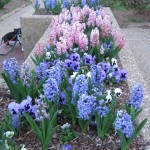My High Country Gardens order arrived. I’m somewhat disappointed by the tiny specimens I was sent. Given that they appear so delicate, I’m placing them under grow lights for the time being.
Check out the new blooms on the ornamental pepper Purple Flash and the “perennial” Easy Wave Petunias. The red petunias have opened, while white buds threaten on the other.
Lavender stoechas Bella Purple is in bloom. The buds appeared about a month ago, and I’ve been reluctant to shear it back since it started to sprawl. As soon as the blooms have faded, I’m trimming it back by at least a foot so that the neighboring chives, garlic and sage get more light. Notice the lavender bud with the crane fly perched on it? Crane fly populations have exploded in Texas since the temperatures have warmed up (i.e. early February). There’s not a day that I get in a collision with a cloud of these crane flies while puttering in the yard. A friend indicated that these prey on mosquitoes; however, I researched this and discovered that they do NOT feed on mosquitoes at all. They love nectar and their larvae will feast on vegetation, and may cause considerable damage to turf and plants. I would like to find a natural way to get rid of these flies; maybe by enticing more birds to visit.
I finally caught some good pictures of my yellow salvia greggii in bloom. The camera is still having difficulty capturing the pale yellow colors, but at least I now have a record of it.
The potted oriental artemisias look like they are enjoying the cooler, moist weather. I do recall that these are part shade plants and they experienced a difficult time last year in the full sun. The yarrow I uprooted from the blue bed is adjusting to its temporary home. I also snapped another picture of the growing leeks in the herb garden bed.
I also spent some time this morning sowing more seeds to the bathroom greenhouse. Stardust Ice Plant, Blue Fescue, Dreams Patriot Mix petunias, Zinnia Profusion mix and Zinnia Starlight Rose are now planted. Thankfully I had easy seeds to deal with this recent go-round, pellets and chaff-like seed aren’t as difficult to stick in Jiffy pellets.














































































































